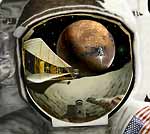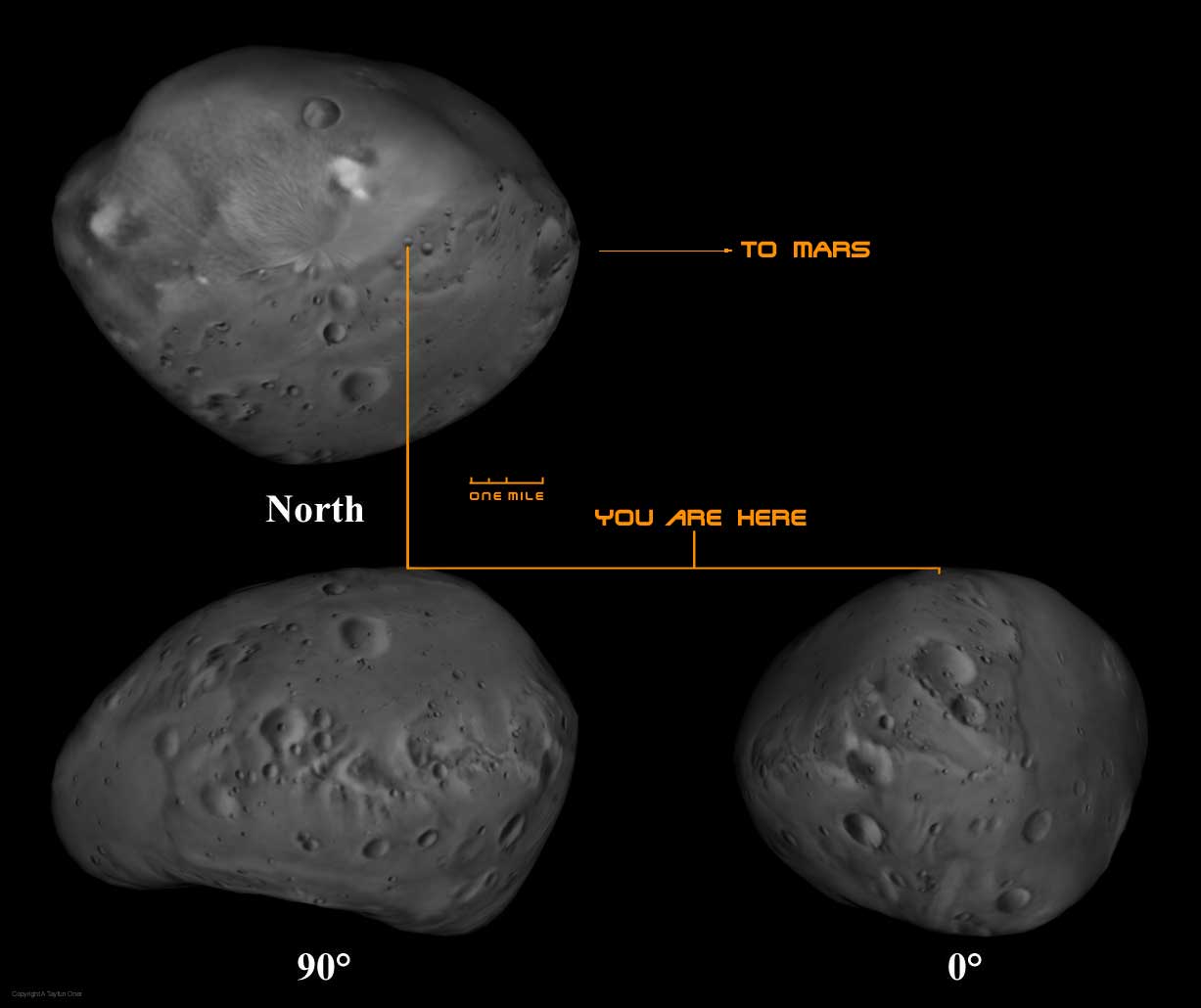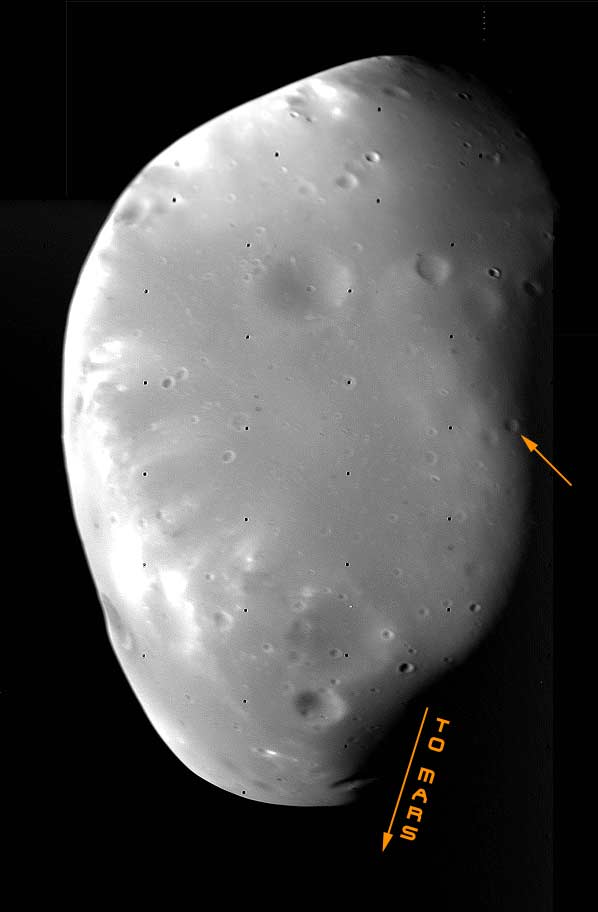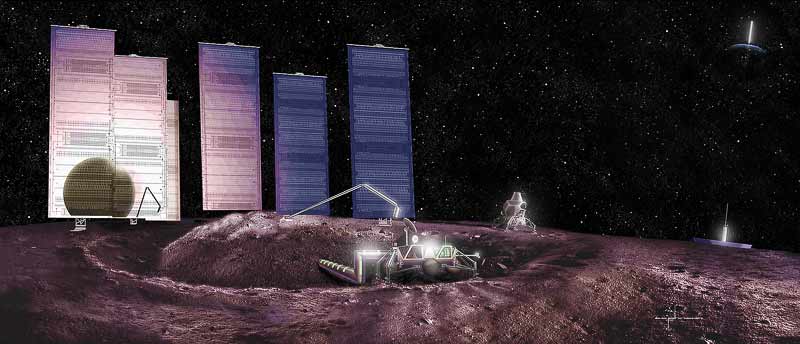 Working On Deimos
Working On DeimosThe Deimos Moon Base
GOING TO MARS BY WAY OF ITS MOONS
Deimos
Second Moon
of Mars
- Diameter: ~10 mi. x ~6.5 mi.
- Mean Surface Gravity: .001g
- Escape Velocity: 12.6 MPH
- Surface Properties: 50 meter thick blanket
of small to medium rocks, mostly fine dust - Orbital Period: 1.26244 Days
- Rotational Period: 1.26244 Days
(Tidally Locked - Near Synchronous)
Once I learned of the conditions, I was faced with the fact that working here presents many problems and would have to spend some amount of time thinking in this environment in order to design for it. It is defintiely an out-of-the-box problem. The escape velocity calculates to little more than
Orthographic Projection
This three view image, combined with the polar photography below, gives us a good handle on where we are going. The chosen crater, indicated on both images, is nearly 1/8 mile in diameter, making it a good target for landing. It sits just forward of the nearly horizontal polar table with respect to the equator and is tipped slightly toward Mars for a good view while providing lateral and aft shielding with its walls. The rotating solar array, addressed below, can be anchored on the smooth plain just behind and above the habitat/lab crater (to the left in the North and 90° views) at highest latitude, less than 1/10 mile away.

Polar photography from 500 km
A mosaic that I assembled from Viking 2 Orbiter photography shows the North polar view of Deimos viewed from the planet side. As you can see, it is pretty darn smooth up there. Not much for surface features and local color - but the view is great!

Landing here, with the low surface gravity and low surface density, will be more of a rendezvous and docking maneuver than a landing. I would not expect that there will be much in the way of exhaust scouring of regolith but some dust may be redistributed by vernier firings. Larger RCS thrusters will most likely not be used to control the descent but instead be reserved for abort. I would expect that a controlled slow fall to the surface, combined with auger screw legs that are counter-rotating at time of touchdown to drill into the 50 meter thick regolith blanket upon contact, would be the most effective method of staying there once you get there. Another method would be to fire harpoons into the regolith from altitude and reel yourself in.
In this low gravity field, the surface will not be very dense. It will not behave in ways that normal dirt would be expected to behave in a one g field, as there has been nothing much to compress it. Think of it as deep snow and how efficient you are at moving in that. It may support you after initial compression but gives way under thrust. Moving shielding materials and larger equipment around would most likely be done with small assist devices, perhaps gas thruster powered, though the dust kicked up by them may itself be problematical.
Huge structures and how to erect and support them are not as difficult as they may seem... merely different in how you go about it. For the most part, you can just land them all in one piece. Keeping tall ones from falling over is another story. Guy wires would be largely ineffective. At the low level on the mast to which they would have to be attached, the lever arm of the upper, unsupported section of the mast would have a large advantage on the lower portion and the low density of the regolith would pose little resistance to the anchors pulling out under steady tension. One good hit off center with a meteor, harmonic oscillations build up and the whole thing gyrates, goes out of column and topples over or flies off into space. Think of it as driving a stake into Corn Flakes, Rice Crispies or Grape Nuts.
Given these limitations for conventional stabilization, one is also given rise to a solution, Just as objects can be pulled out of the regolith with ease, so may large objects be thrust into it. The masts for the solar arrays are designed having a long, narrow, sharp, fluted cone base that is thrust fairly deeply into the regolith by firing it at low velocity from above the surface. The panels are assembled to it and unfurl in place. The whole mast, panels and all, turns on a dual full-floating bearing near the base, driven by a heliostat to follow the Sun as Deimos travels around Mars. The array is situated so that only one panel is eclipsed by another at one time, ensuring that power fluctuations will be kept within design limits.
Burying the habitat can be done in a number of ways, but it does pose its own problems. Heavy equipment would not be very effective in this low gravity field, if at all—mostly because it wouldn't be heavy. Get a blade full of dirt and your tracks will simply dig out from under you.
It may take a while to move that much mass, but a good ol' HUGE hand shovel might be all that is really needed—but that isn't very glamorous. A beefed-up RMS style arm on top of the habitat that pulls the crater limb in backhoe fashion would be most effective, as the lab is already screwed into the surface. Leverage, rather than brute force. With the scraper removed, the arm serves as a crane for working in close proximity to the lab.
On the other hand, a triad of properly calculated and placed shaped charges would be most efficient to move the dirt where you want it. WHUMP! Create three new craters and do seismic studies all at the same time. It'll take a while for the dust to settle in this low gravity but we'll at least get a show and some new scenery out of the operation.
And all that looks like....

|
Comments & questions are welcomed. Images & Text Copyright © 1976-2024 B.E.Johnson, All Rights Reserved |